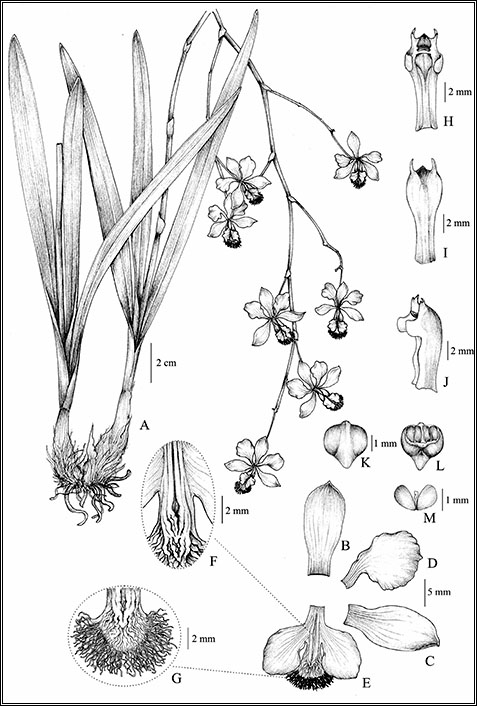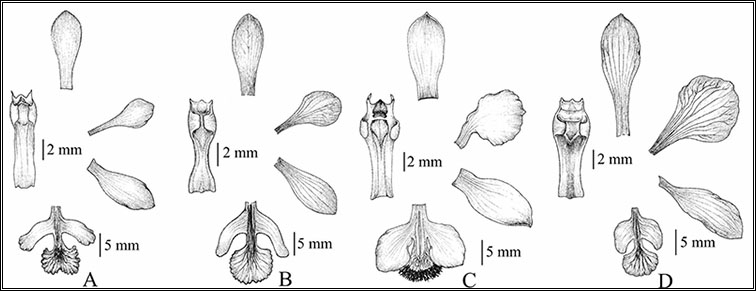A recently described species to the state of Bahia, in Brazil. It is the unique
in the genus for having a fimbriate labellum. Materials and methods Taxonomy Type:—BRAZIL: Bahia: southeastern portion of the state, 19 January 2006, Thomas et al. 14604 (holotype CEPEC!). Epiphytic herb. Pseudobulbs ovoid, 5.0-6.0 × 1.0-1.5 cm. Leaves 3, narrow-lanceolate, 20.0-26.7 × 1.0-1.4 cm. Inflorescence a double raceme, weakly branched; peduncle 53.6 × 0.3 cm, peduncle bracts closed, obconic, 1.4 × 0.8 cm; rachis up to 30.0 cm long; floral bracts deltoid, 0.4 × 0.3 cm. Flowers resupinate; pedicel 3.0 cm long; ovary 0.3 cm wide, smooth; sepals obovate, slightly concave, base constricted, margin entire, patent, tan-olive, dorsal sepal with apex obtuse, 1.3-1.9 × 0.6-0.8 cm, lateral sepals apiculate, 1.5-1.8× 0.6-0.9 cm; petals oblique, spathulate, patent, tan-olive, margin gently wavy, about 1.5 × 1.0 cm; lip trilobed, cream streaked with purple, 1.5 × 2.0 cm, lateral lobes obovate, oblique, base constricted, apex obtuse to rounded, margin entire, oblique in angle of 50°, 1.3 × 0.8 cm, median lobe 1.5 × 1.0 cm, reniform, margin fringed, fringes 0.25 cm long; two longitudinal and parallel calli united to form crests in the terminal portion, apices of the calluses ending in the center of the median lobe; column semi-clavate, 1.0 × 0.3 cm, clinandrium apex tridentate, median tooth triangular, lateral teeth horn-like, apices praemorse, stigma obovate, rostellum triangular, protruding, revolute; column wings oblong, involute, apex truncate; anther oblong, rostrate, 0.3 × 0.2 cm, pollinia 4, in pairs, ovate, laterally compressed, waxy, equal, yellow, granular caudicle. Capsule not seen. Distribution:—Found so far only in southern portion of Bahia State, Brazil, 850–990 m in montane wet forest, known from a single collection. Etymology:—From the Latin fimbriatus, in reference to the fimbriate midlobe of this species, not observed in any previously known species in the genus. Discussion:—Floral morphology of Encyclia fimbriata indicates affinities with E. fowliei Duveen (1990: 38), endemic to southern Bahia and also an epiphyte in Atlantic Forest (Fowlie & Duveen 1992, Barros et al. 2010). Similarities include the tan-olive color of the petals and sepals, ovate sepals and spathulate petals, as well as the gently wavy margins of the latter (Fig. 2). Nevertheless, the much larger lip of E. fimbriata, hornlike teeth of the clinandrium and protruding rostellum are reminiscent of E. euosma (Reichenbach 1877: 79) Porto & Brade (1935: 28). The wavy midlobe of E. bragancae Ruschi (1975: 84) and horn-like teeth of the clinandrium also suggest a relationship between E. fimbriata and the last. Encyclia fimbriata can be separated from similar species by several features of its floral morphology and distribution (Table 1).
TABLE 1. Comparison of floral morphology for Encyclia bragancae, E.
euosma, E. fowliei and the new species, E.
There is a published list of the flowering plants in the area where the type specimen was collected (Amorim et al. 2009). In this list only two Encyclia were reported and not identified to species level, as Encyclia sp. 1 and Encyclia sp. 2. The latter corresponds to E. fimbriata, here described, whereas Encyclia sp. 1 is in fact a specimen of E. unaensis Fowlie (1991: 26), vegetatively much smaller than E. fimbriata and with completely different flowers. The measurements in our description above are based on the single specimen available to us, but we have bracketed these data a little so that the description is more likely to apply to additional collections, if they are ever made. Acknowledgements
Barros, F., Vinhos, F., Rodrigues, V.T., Barberena, F.F.V.A. & Fraga, C.N. (2010) Orchidaceae. In: Forzza, R.C., Leitman, P.M., Costa, A., Carvalho Junior, A.A., Peixoto, A.L., Walter, B.M.T., Bicudo, C., Zappi, D., Costa, D.P., Lleras, E., Martinelli, G., Lima, H.C., Prado, J., Stehmann, J.R., Baumgratz, J.F.A., Pirani, J.R., Sylvestre, L.S., Maia, L.C., Lohmann, L.G., Paganucci, L., Silveira, M., Nadruz, M., Mamede, M.C.H., Bastos, M.N.C., Morim, M.P., Barbosa, M.R., Menezes, M., Hopkins, M., Secco, R., Cavalcanti, T. & Souza, V.C. (coord.) Catálogo de plantas e fungos do Brasil. Vol. 2. Instituto de Pesquisas Jardim Botânico do Rio de Janeiro, Rio de Janeiro, pp. 1344–1426. Campacci, M.A. (2003) O gênero Encyclia. Coletânea de Orquídeas brasileiras 1: 1–32. Castro Neto, V.P. (2006). Encyclia. Icones orchidacearum Brasiliensis 1: 135–143. Castro Neto, V.P. & Campacci, M.A. (2003) Encyclia. Icones orchidacearum Brasiliensis 1: 44–77. Chase, M.W., Cameron, K.M., Barret, R.L. & Freudenstein, J.V. (2004) DNA
data and Orchidaceae systematics: a new
phylogenetic classification. In: Dixon, K.W., Kell, S.P., Barrett, R.L. &
Cribb, P.J. (orgs.) Orchid conservation. Dressler, R.L. (1993) Phylogeny and classification of the orchid family. Cambridge University Press, Cambridge, 314 pp. Dressler, R.L. & Pollard, G.E. (1974) The genus Encyclia in Mexico. Asociación Mexicana de Orquidología, A. C., México, 151 pp. Duveen, D.I. (1990) Spectacularly flowered new species of Encyclia from Brazil, Encyclia fowliei. Orchid Digest 54: 38–39. Fowlie, J.A. (1991) A new Encyclia species from the floodplains of Una (Bahia), Encyclia unaensis Fowl., sp.nov. Orchid Digest 55: 26–27. Fowlie, J.A. & Duveen, D. (1992) A contribuition to an understanding of the genus Encyclia as it occurs in the Brazilian shield and its river tributaries. Orchid Digest 56: 171–206. Harris, J.G. & Harris, M.W. (1994) Plant identification terminology: an illustrated glossary. Spring Lake Publishing, Payson (Utah), 189 pp. Higgins, W.E., van den Berg, C. & Whitten, W.M. (2003) A combined molecular phylogeny of Encyclia (Orchidaceae) and relationships within Laeliinae. Selbyana 24: 165–179. Pabst, G.F.J. & Dungs, F. (1975) Orchidaceae Brasilienses 1. Brücke, Hildesheim, 408 pp. Pabst, G.F.J. & Dungs, F. (1977) Orchidaceae Brasiliensis 2. Brücke, Hildesheim, 418 pp. Porto, P.C. & Brade, A.C. (1935) Index Orchidacearum in Brasilia inter MDCCCCVI et MDCCCCXXXII explorata sunt. Rodriguésia 1: 11–76. Pridgeon, A.M., Cribb, P.J., Chase, M.W. & Rasmussen, F.N. (2003) Genera orchidacearum, Epidendroideae (part 1). Vol. 4. Oxford University Press, Oxford, 672 pp. Reichenbach f., H.G. (1877) Epidendrum (Encyclium) euosmum. Linnaea 41: 79. Ruschi, A. (1975) Orquidaceas novas do Estado do Espírito Santo. Boletim do Museu de Biologia Prof. Mello-Leitão 84: 1–3. Stearn, W.T. (2004) Botanical Latin. Timber Press, Portland, 546 pp. van den Berg, C. & Carnevali F.-C., G. (2005) Encyclia. In: Pridgeon,
A.M., Cribb, P.J., Chase, M.W. & Rasmussen, F.N. Weberling, F. (1989) Morphology of flowers and inflorescences. Cambridge University Press, Cambridge, 423 pp. Withner, C.L. (1998) The cattleyas and their relatives: Brassavola, Enyclia,
and other genera of Mexico and Central Withner, C.L. (2000) The cattleyas and their relatives: The South American Encyclia Species. Vol. 6. Timber Press, |


